#paravians
Text

Urvogel
(First art of 2024 yippee)
#art#illustration#my art#digital art#paleoart#paleontology#palaeoblr#birblr#archosaurs#dinosaurs#theropods#coleurosaurs#maniraptorans#paravians#birds#archaeopteryx#tumblr radar
2K notes
·
View notes
Text
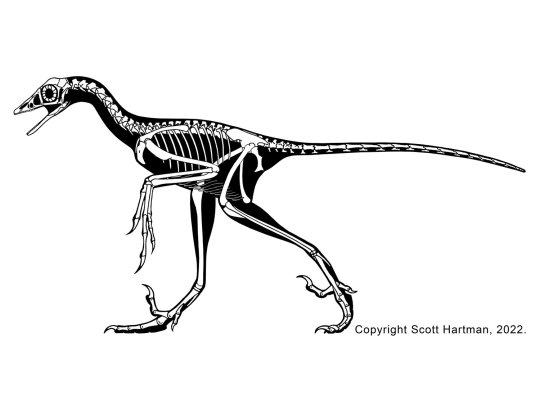

One of these is a dinosaur and one is a bird. As you can see, they are clearly soooo radically different from each other that there cannot possibly be any overlap between these two groups. Drawing a line between dinosaurs and birds is easy! You just have to, uh, ummm, uhhh....... quick, what's that! [disappears in a puff of smoke]
554 notes
·
View notes
Text
175 notes
·
View notes
Text


#Archovember Day 1 - Your Choice!
In my ongoing effort to draw all the non-avian dinosaurs we know the colors of, I’ve chosen Anchiornis huxleyi!
The type species for the Anchiornithids (“near birds”), Anchiornis huxleyi was a crow-sized dinosaur living in the Late Jurassic of Liaoning, China. It was relatively common, as hundreds of specimens have been uncovered in this area. But what makes Anchiornis so unique and important is that it was the first Mesozoic dinosaur species to have its entire life appearance be known by man! Having hundreds of well-preserved fossils available allows us to extract a lot of information about not only its size and shape, but its skin, feathers, and even coloration. Anchiornis had long wing feathers on its arms and legs (though its leg feathers were not as long as those of Microraptorians), fluffy downy feathers all over its body, a feathered crest on its head, and feathers covering its feet.
Only two Anchiornis fossils have had their well-preserved melanosomes studied so far. By comparing the structure of these melanosomes to modern birds, paleontologists have been able to infer the life colors of Anchiornis! It had mostly gray and black body feathers and white forewing and hindwing feathers with black tips. Its tail colors remain unknown. The first specimen of Anchiornis to be surveyed for melanosomes also had red or rufous coloring on its crest, as well as rufous speckles on its otherwise black and gray head. However, the second specimen did not have any rufous coloration. This may be due to different preservation of melanosomes, different investigative techniques, the animals in question having regional differences or even being different species/subspecies, the second Anchiornis being younger, or sexual dimorphism.
While Anchiornis had rather large feathered forelimbs, it didn’t seem to have been much of a flier. Unlike the later Microraptorians, its wings were rounded and relatively short compared to other flying dinosaurs, and the flimsy flight feathers overlapped each other to strengthen them. A 2016 study concluded that while juvenile Anchiornis may have been able to use their wings to assist with leaping through the trees, adults were simply too heavy and their wings too small to gain any lift. Instead, it is more likely their wings were used for display. As their legs were long, they may have been adapted for speed, using their wings to aid in aerodynamics as they quickly darted through the underbrush.
Pellets (such as those coughed up by owls) have been found both within and in association with Anchiornis, and contained lizard bones and fish scales. Prey items that could have also been eaten by Anchiornis include insects, arachnids, salamanders, small anurognathids (such as Cascocauda, who we will be visiting later this month) and other small or juvenile pterosaurs, and small cynodonts like Agilodocodon and Juramaia.
Anchiornis lived alongside other Anchiornithids such as Aurornis, Caihong, Eosinopteryx, Pedopenna, Serikornis, Xiaotingia, as well as the Scansoriopterygids Yi, Scansoriopteryx, and Epidexipteryx. It also lived alongside the quilled heterodontosaurid Tianyulong.
#my art#SaritaDrawsPalaeo#Anchiornis huxleyi#Anchiornis#Anchiornithid#paravian#theropods#saurischians#dinosaurs#archosaurs#archosauromorphs#Archovember#Archovember2023
25 notes
·
View notes
Text
I WILL gatekeep insomnia if melatonin does anything to you you’re not insomniac you're just a little restless
4 notes
·
View notes
Text
Anchiornis

Anchiornis is a small paravian dinosaur from the Late Jurassic of China. It could grow to around 60 cm in body length with a wingspan nearly as wide, and weighed about 1 kg. In addition to the front wings, Anchiornis had long feathers on the hind legs, leading many scientists to call it a four-winged dinosaur. Thanks to an extremely well-preserved specimen, scientists have been able to study the melanosomes in the feathers and determine the full body colors and patterns of Anchiornis. The body was mainly black and gray and the primary feathers were white with black tips and patterns. It also sported a red crest on the top of its head.
118 notes
·
View notes
Text
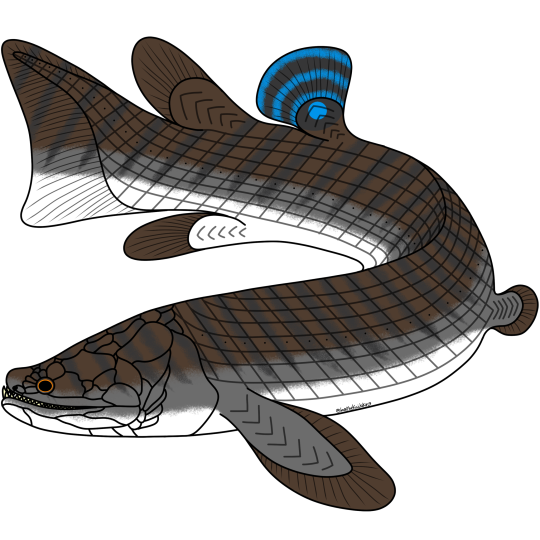
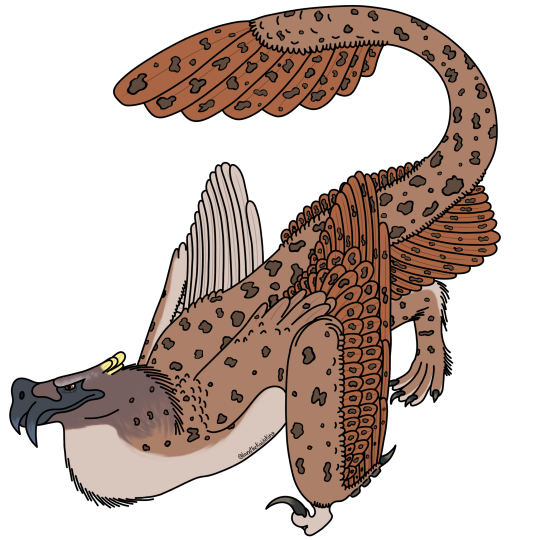
Art commissions for @glavenychus and @bogbiter
An amphibious mangrove dwelling Porolepiform for Glave’s permotriad
And a paravian descendant West Asian Griffin for Bog’s book series Awakened: Bleeding Realm
#art#commissions#speculative evolution#speculative ecology#speculative biology#griffin#glavenychus#bogbiter#awakened: bleeding realm#permotriad
29 notes
·
View notes
Text

Today's dinosaur is Rahonavis, a late Cretaceous Paravian, hypothesized to be capable of powered flight
51 notes
·
View notes
Text

New Paravian flying wyvern ancestor design
its been quite a while since i've done some monster hunter stuff so i wanted to do something related to it and i decided to revist my parave wyvern design i made like almost 7 months ago and i really didnt like how it looked so i decided to redesign it!
it is based of @iamthekaijuking's theory on every flying/bird wyverns being descendant from a small paravian dinosaur that evolved more flexible hands to climb and burrow aswell as growing pseudo fingers for wings!
mine has 2 more pseudofingers on each hands one for the wing and one for an opposable thumb as i thought it would look neat aswell as making my creature being able to climb and dig better aswell as interacting with the environment as it was my idea i had when i first made this little fella!
14 notes
·
View notes
Text
It Came From The Wastebasket #12: Coelurosaur Confusion
Historically Coelurosauria was the counterpart to the Carnosauria, with both of them representing two major lineages of theropod dinosaurs.
Created as a group in the early 20th century, coelurosaurs quickly became a dumping ground for all small-bodied theropods – including coelophysoids, compsognathids, ornithomimids, oviraptorosaurs, dromaeosaurids, and troodontids– and for a while this wastebasket taxon also included the large-bodied ceratosaurids and tyrannosauroids, before they were moved over into the carnosaurs.
But during the 1960s and 1970s this arrangement began to break down. A better understanding of groups like dromaeosaurs revealed a confusing mixture of traditional "carnosaur" and "coelurosaur" anatomical features, and paleontologists struggled to figure out where these sorts of theropods actually fit in.
The development of cladistic methods from the 1970s onwards led to efforts to clean up the coelurosaur wastebasket, trying to figure out a more accurate version of these animals' evolutionary relationships. After briefly collapsing Coelurosauria down to just coelophysoids and "coelurids", the growing recognition of modern birds as living theropod dinosaurs eventually resulted in the group being properly redefined in the 1980s as "birds, and all theropods closer related to them than to carnosaurs".

Clockwise from the left (not to scale): Citipati osmolskae, Albertosaurus sarcophagus, Yi qi, Sinosauropteryx prima
The coelophysoids were finally removed entirely, reclassified as a much earlier branch of theropods – but quite a few of the other groups from earlier concepts of Coelurosauria survived this reshuffling, with the compsognathids, ornithomimids, oviraptorosaurs, dromaeosaurs, and troodontids all proving themselves to have really been closely related the whole time. Meanwhile the tyrannosauroids were brought back in, along with the therizinosaurs, alvarezsauroids, and a whole bunch of paravian and avialan lineages.
(Megaraptorans might belong somewhere in the coelurosaurs, too – possibly being tyrannosauroids – but their classification is currently being disputed.)
———
Nix Illustration | Tumblr | Twitter | Patreon
#it came from the wastebasket#wastebasket taxon#taxonomy#coelurosauria#theropod#dinosaur#paleontology#art#science illustration#paleoart#palaeoblr
231 notes
·
View notes
Text

Imparavis
Edit: I redrew this
#couldn't find much info about the beak shape :pensive:#art#my art#digital art#paleoart#paleontology#palaeoblr#birblr#archosaurs#dinosaurs#theropods#coleurosaurs#maniraptorans#paravians#birds#enantiornitheans#imparavis
126 notes
·
View notes
Text
Now myself, I like to consider paravians as the starting point for birds because (1) going crown group only is just silly [gestures to enants] but (2) there really just isn’t any meaningful distinction between early avialans and dromaeosaurs, and (3) if we go with powered flight, it probably happened a bunch of times in paraves anyway…
But that’s just me being the resident paravian propaganda artist. :P Go and call all of ornithodira birds, it’s fine.
#god imagine if we had living pterosaurs#they’d be the avian equivalent of the platypus#bird political spectrum#paravian propaganda
18 notes
·
View notes
Text
Fossil Novembirb 8: The Raptors Are Back
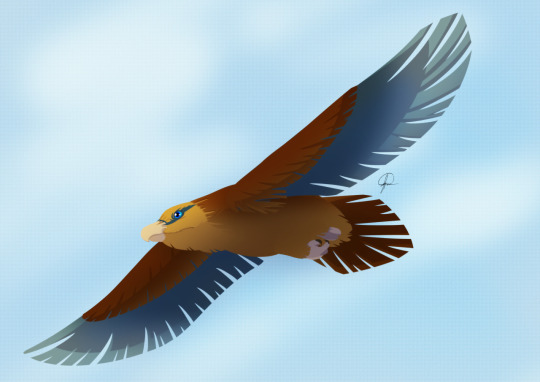
Palaeohierax by @quetzalpali-art!
Alright we're back with a look at the raptors of the Paleogene!
Raptor meaning, of course, bird of prey. Which I wouldn't have to say, except this is a dinosaur blog, and a lot of the time people in dinosaur circles use "raptor" to mean "Dromaeosaur" exclusively. Ironic, given that birds of prey used the word first!

Pulchrapollia by @drawingwithdinosaurs
We've already talked about some of the birds of prey that appeared right after the extinction, such as all the early owls, Qianshanornis, and Danielsraptor. Truth is, being a carnivore is a useful ecology, and birds - having evolved from Paravians like Dromaeosaurs - already have a lot of the tools for chowing down! So, carnivorous birds just keep re-evolving all the time - corvids are sometimes considered raptors, and they're deeply nested within Passerines! And of course, modern roadrunners are essentially mini Velociraptors, but they're cuckoos!
In fact, it seems that most birds alive today evolved from a carnivorous ancestor! All the early-branching members of Telluraves, aka "Core Land Birds" (which includes all passerines and many more besides) are raptorial - owls, hawks, eagles, kites, seriemas, even falcons. And the early ancestors of Passerines and Parrots - things like Halcyornis - were birds of prey as well!
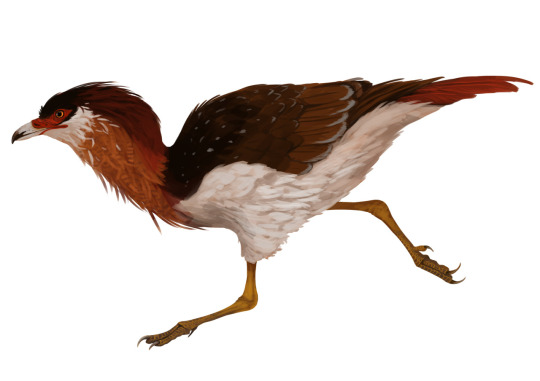
Dynamopterus by @thewoodparable
As we saw with Danielsraptor and Qianshanornis, fast running predatory birds have been a thing since the ash started clearing up from the asteroid. There are just so many small animals to eat and so little time to catch them! Relatives of falcons and seriemas continued to pursue (heh) this lifestyle, and were quite common in the Paleogene fossil record.
In fact, Seriemas - today limited to just a handful of species in South America - had a very successful time of it during the Paleogene and Neogene, with species spread all across the globe. Dynamopterus (sometimes called Idiornis) was from the later Eocene of Europe, and it lived very similarly to living seriemas in its ecosystem! Itaboravis was present in the early Eocene in South America, and we also have Bathornis in North America!
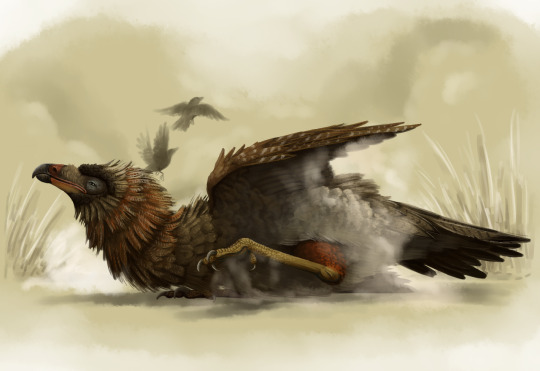
Bathornis by @drawingwithdinosaurs
Bathornis was a very terror-bird-like seriema relative that lived in North America from the Eocene through the Miocene, found in many different environments and at many sizes throughout its existence, including plains and wetlands. Flightless like its terror bird cousins, it had a strong beak to help in catching food and powerful legs for moving quickly across the landscape to catch it!

Ogygoptynx by Apokryltaros/Avancna
Of course, I cannot ignore flighted predatory birds entirely. Though modern ones don't have a lot of fossil relatives (they start appearing in the Oligocene with forms like Palaeohierax), it seems that volant raptors were simply found in other clades - many owls were diurnal, and the relatives of modern parrots and passerines were small carnivores as I mentioned above. With ridges over their eyes to help with glare, these animals could find prey over long distances and fly to them rapidly from their perches - something quite terrifying for the little mammals they ate!
From grasping talons to sickle claws to powerful beaks and eyes, these animals - though small - had major impacts on their environments. Some grew to be so large they would hunt humans - but that's a story for another article.
Sources:
Mayr, 2022. Paleogene Fossil Birds, 2nd Edition. Springer Cham.
Mayr, 2017. Avian Evolution: The Fossil Record of Birds and its Paleobiological Significance (TOPA Topics in Paleobiology). Wiley Blackwell.
88 notes
·
View notes
Text
Migmanychion laiyang Wang et al., 2023 (new genus and species)
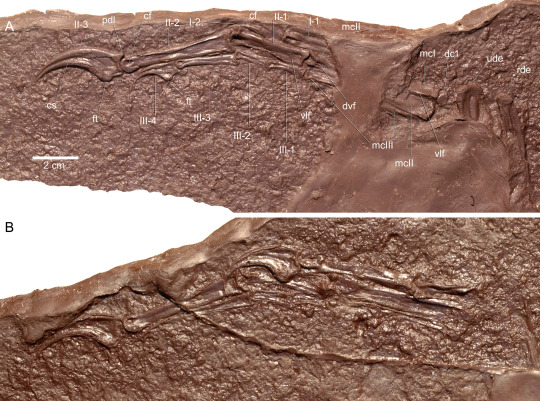
(Cast of the hand of Migmanychion laiyang, from Wang et al., 2023)
Meaning of name: Migmanychion = claw mixture [in Greek]; laiyang = Laiyang [referencing the Shandong Laiyang Cretaceous National Geological Park, where the original fossil is housed]
Age: Early Cretaceous (Aptian), about 121 million years ago
Where found: Longjiang Formation, Inner Mongolia, China
How much is known: A partial left forelimb (including a complete hand) and some rib fragments of one individual.
Notes: Migmanychion was probably a maniraptoran, a diverse group of feathered theropods including alvarezsaurs, therizinosaurs, oviraptorosaurs, and paravians (which in turn include birds). The bones in its hands were very slender and its hand claws were not sharply curved. A particularly unusual feature of its hands was that the claw of the second finger (equivalent to our index finger) was longer but not as deep as the thumb claw. In most other theropods, the longest hand claw is also the deepest.
Migmanychion might have been closely related to Fukuivenator, a maniraptoran from the Early Cretaceous of Japan that some recent studies suggest was an early therizinosaur. However, more complete specimens will likely be needed to confidently determine what type of maniraptoran Migmanychion was.
Reference: Wang, X., A. Cau, Z. Wang, K. Yu, W. Wu, Y. Wang, and Y. Liu. 2023. A new theropod dinosaur from the Lower Cretaceous Longjiang Formation of Inner Mongolia (China). Cretaceous Research advance online publication. doi: 10.1016/j.cretres.2023.105605
63 notes
·
View notes
Text
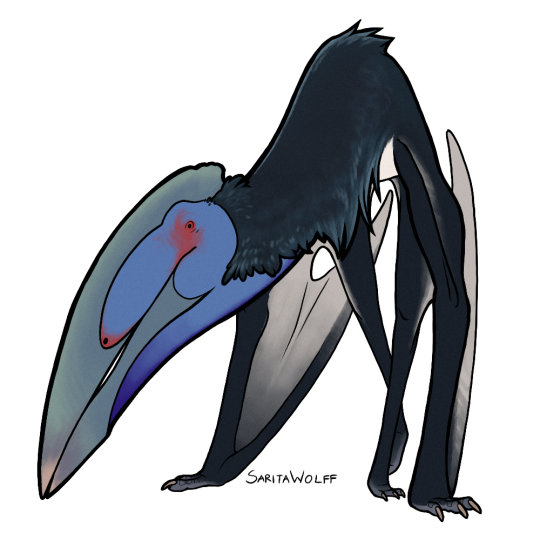
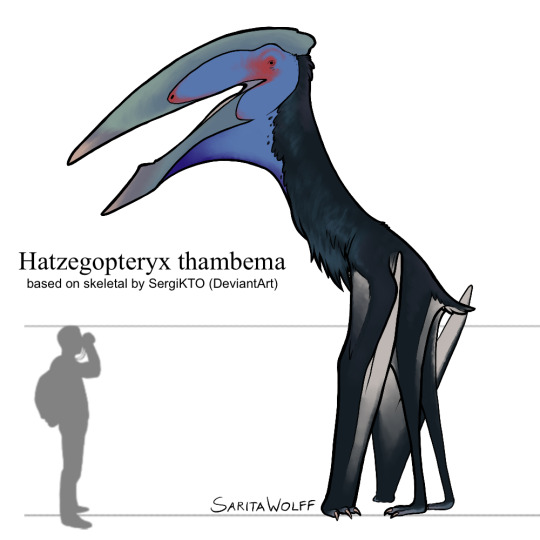
#Archovember Day 3 - Hatzegopteryx thambema
This awful tangle of limbs is Hatzegopteryx, who also got its bigscreen debut this year with Prehistoric Planet! This giant azhdarchid pterosaur was native to what is now Romania, but in the Late Cretaceous was an island in the prehistoric Tethys Sea called “Hateg Island.” Hateg Island was host to a variety of unique fauna, including the dwarf titanosaurs Magyarosaurus and Paludititan, the dog-sized iguanodontian Zalmoxes, and the stocky, double-sickle-clawed paravian Balaur bondoc. In the absence of any giant carnivorous theropods, it’s likely Hatzegopteryx was the apex predator of Hateg Island. It also had a shorter, more muscular neck than other azhdarchids, likely due to its diet of larger animals.
#my art#Hatzegopteryx#Hatzegopteryx thambema#azhdarchid#pterosaurs#archosaurs#archosauromorphs#SaritaDrawsPalaeo#Archovember#Archovember2022#Dinovember#Dinovember2022#DrawDinovember#DrawDinovember2022
194 notes
·
View notes